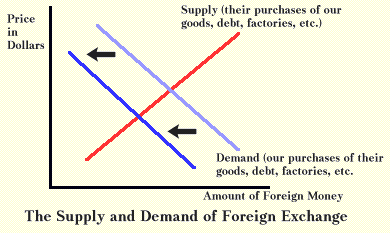Assets or CREDITS ( + ) , Demand for $ , "Inflows"
- Current Accounts :
- Balance on Goods and Services
- Net Exports ( Xn )
- Balance of Trade
- Exports ; tourism Here ( ex : Disney World )
- Net Investments
- interest / dividend payments foreigners paid to U.S. for the use of exported capital
- Net Transfers
- Aid to U.S.
- Transfer back to U.S.
- Royal ties
- ex : wrote a song, but other people use it ( copyright )
- Capital / Financial Accounts :
- Capital / Inflows
- Direct investment in the U.S. by foreigners
- Purchase of stocks and bonds by foreigners
- Official Reserves
- Currencies
- IMF ( international monetary funds ) Holdings
- Gold
Liabilities or DEBITS ( - ) , Supply of $ , "Outflows"
- Current Accounts :
- Balance on Goods and Services
- Net Exports ( Xn )
- Balance of Trade
- Imports ; tourism There ( ex : Paris )
- Net Investments
- interest / dividend payments the U.S. made for the use of foreign capital invested in the U.S.
- Net Transfers
- Aid to Them
- Remittance from the U.S.
- Their Royalties
- Capital / Financial Accounts :
- Capital / Outflows
- Direct investment in the U.S. over There
- Purchase of stocks and bonds by the U.S.
- Official Reserves
- Currencies
- IMF ( international monetary funds ) Holdings
- Gold
Balance Trade :
- goods and service EXPORT - goods and service IMPORT
Trade Deficit when balance on trade is negative :
Trade surplus occurs when balance of trade is positive :
- balance of trade + net investment + net transfer
Capital Account :
- foreign purchase of you country's asset + your country's purchase of assets abroad
Official Reserves ( ALWAYS POSITIVE )
- Current Account + Capital Account
Balance of Goods and Service :
- goods import + services import
Balance of Trade :
- goods export + goods import
